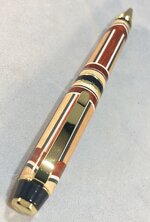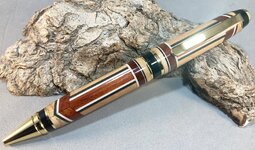KMCloonan
Member
During Covid, with nothing else to do, I practically lived on this site, absorbing a lot of the library topics, trying pen making techniques I had never done before. Those were heady times (except for the Covid part). I did a lot of segmenting in a short period of time and usually was thrilled with the results. Then in 2022 I began immersing myself into casting and hybrid blank making, and pretty much abandoned segmenting for a couple years.
Earlier this year, at the Midwest Penturners Gathering, I was fortunate to receive 2 large flat rate boxes of segmenting materials (veneers, thinly sliced woods, etc.) from Mark James.
I just recently dug into those boxes and started segmenting again but was dismayed that, during Covid, I took zero notes of how I made the various segmented pens I had made. All I have are pictures of the pens I made, and I'm scratching my head wondering "how the heck did I make that?" I am still relearning how to do various segmenting styles. I liken it to being a runner (of which I am not), who stops running for a while - restarting is always challenging, until you are back in shape.
The upside is that I am now taking notes/sketches/pictures as I make segmented pens so I can refer to them in the future.
Here's my first pen using Mark James' materials (Padauk, Beech (I think), and oak, with Vulcanized Paperboard dividers).





Mark James, thank you once again for your generosity! It will take me years to work my way through all the materials you gave me, and I look forward to every pen I make with the materials!
Earlier this year, at the Midwest Penturners Gathering, I was fortunate to receive 2 large flat rate boxes of segmenting materials (veneers, thinly sliced woods, etc.) from Mark James.
I just recently dug into those boxes and started segmenting again but was dismayed that, during Covid, I took zero notes of how I made the various segmented pens I had made. All I have are pictures of the pens I made, and I'm scratching my head wondering "how the heck did I make that?" I am still relearning how to do various segmenting styles. I liken it to being a runner (of which I am not), who stops running for a while - restarting is always challenging, until you are back in shape.
The upside is that I am now taking notes/sketches/pictures as I make segmented pens so I can refer to them in the future.
Here's my first pen using Mark James' materials (Padauk, Beech (I think), and oak, with Vulcanized Paperboard dividers).





Mark James, thank you once again for your generosity! It will take me years to work my way through all the materials you gave me, and I look forward to every pen I make with the materials!

